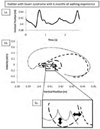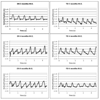Lyapunov exponent and surrogation analysis of patterns of variability: profiles in new walkers with and without down syndrome
- PMID: 20237407
- PMCID: PMC2958097
- DOI: 10.1123/mcj.14.1.126
Lyapunov exponent and surrogation analysis of patterns of variability: profiles in new walkers with and without down syndrome
Abstract
In previous studies we found that preadolescents with Down syndrome (DS) produce higher amounts of variability (Smith et al., 2007) and larger Lyapunov exponent (LyE) values (indicating more instability) during walking than their peers with typical development (TD) (Buzzi & Ulrich, 2004). Here we use nonlinear methods to examine the patterns that characterize gait variability as it emerges, in toddlers with TD and with DS, rather than after years of practice. We calculated Lyapunov exponent (LyE) values to assess stability of leg trajectories. We also tested the use of 3 algorithms for surrogation analysis to investigate mathematical periodicity of toddlers' strides. Results show that toddlers' LyE values were not different between groups or with practice and strides of both groups become more periodic with practice. The underlying control strategies are not different between groups at this point in developmental time, although control strategies do diverge between the groups by preadolescence.
Figures





References
-
- Abarbanel HDI. Analysis of observed chaotic data. New York: Springer-Verlag; 1996.
-
- Alton F, Baldey L, Caplan S, Morrissey LC. A kinematic comparison of overground and treadmill walking. Clinical Biomechanics. 1998;13(6):434–440. - PubMed
-
- Bagiella E, Sloan RP, Heitjan DF. Mixed-effects models in psychophysiology. Psychophysiology. 2000;37(1):13–20. - PubMed
-
- Black DP, Smith BA, Wu J, Ulrich BD. Uncontrolled manifold analysis of segmental angle variability during walking: Preadolescents with and without Down syndrome. Experimental Brain Research. 2007;183(4):511–521. - PubMed

